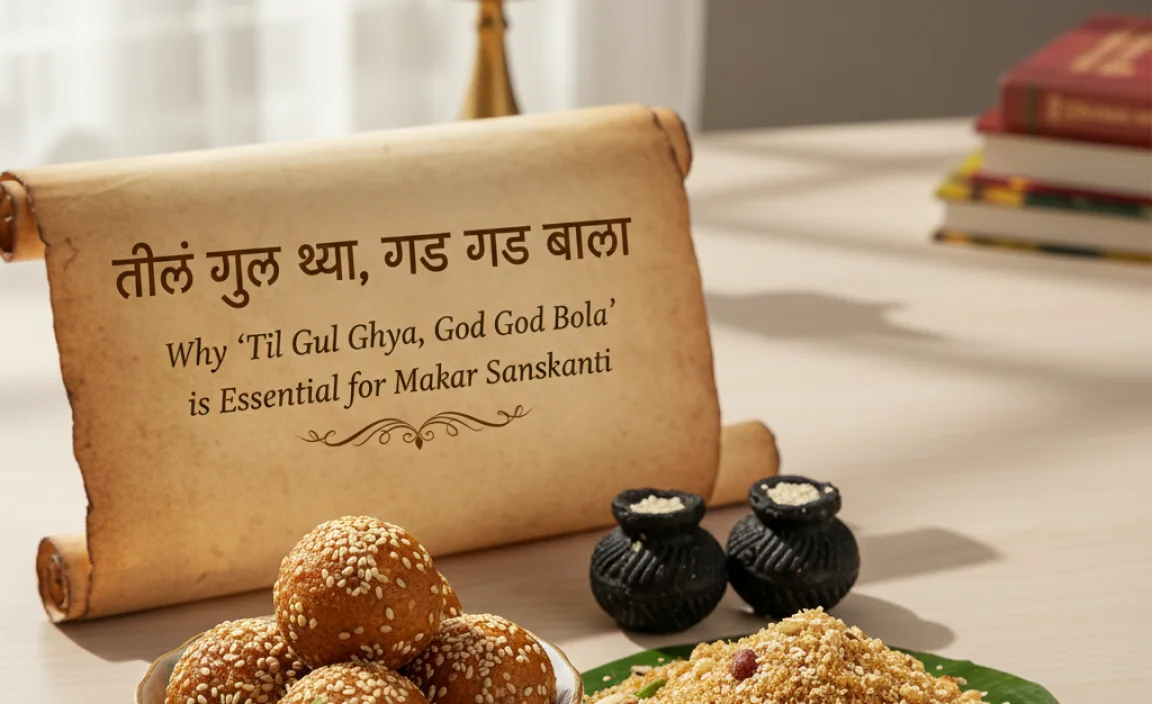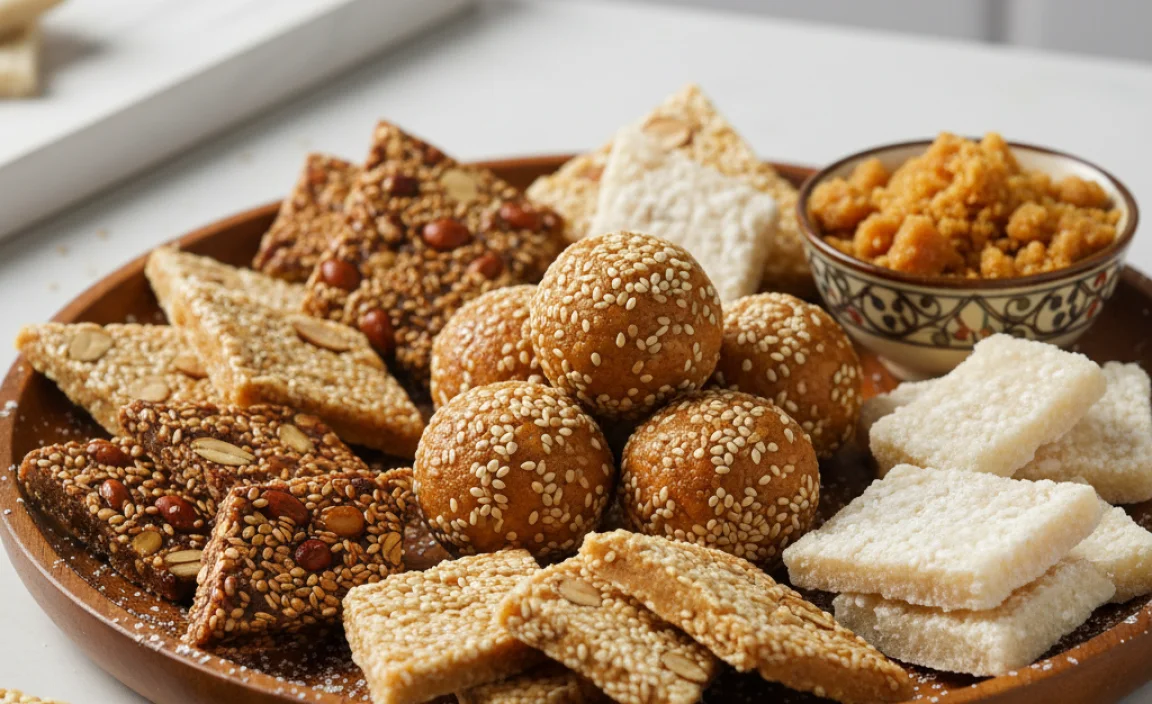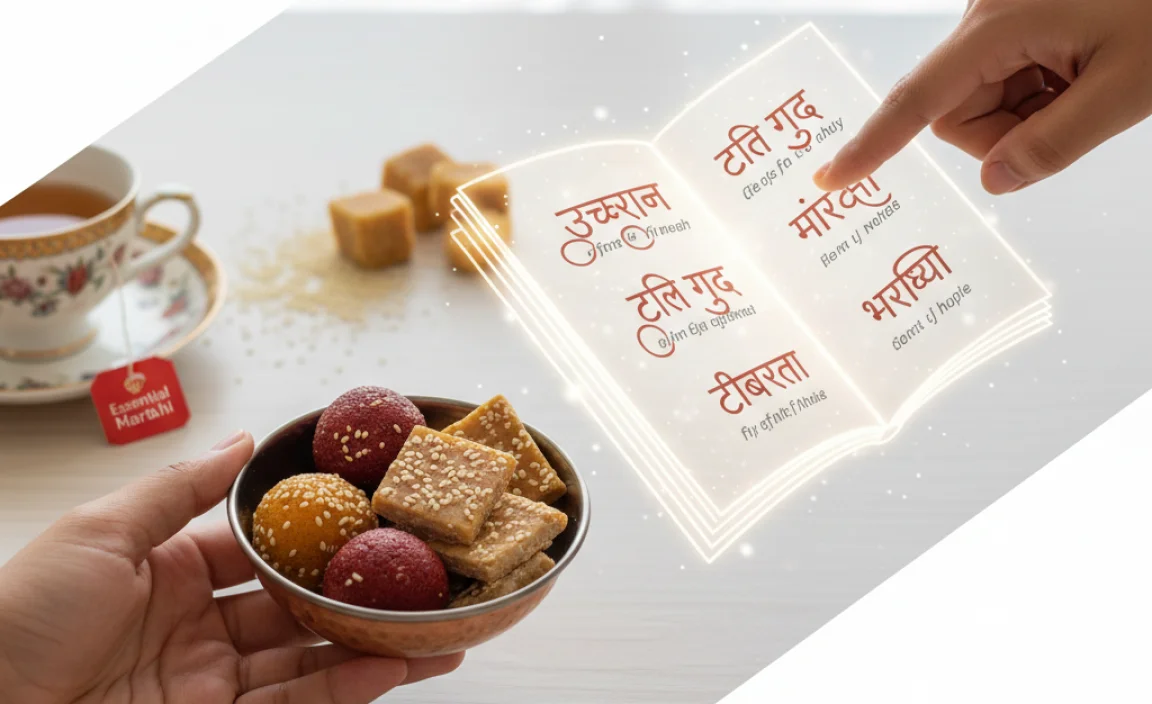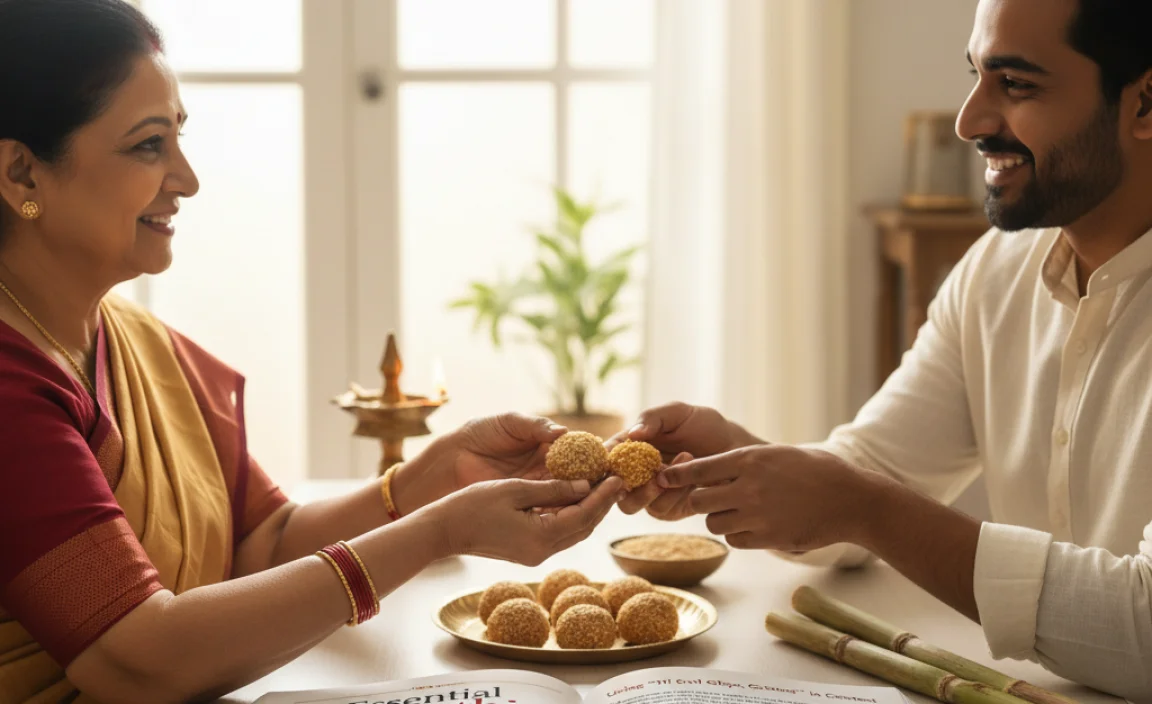Til Gul Ghya God God Bola: Essential Marathi
Understand “Til Gul Ghya God God Bola” for a Sweet Marathi Greeting.
This phrase, meaning “Take sesame seeds and jaggery, speak sweetly,” is essential for Makar Sankranti. It’s a warm invitation to share joy and good wishes. Mastering its meaning and context helps you connect with Maharashtrian culture. We’ll break down its significance and how to use it gracefully this festive season.
Makar Sankranti is a vibrant festival celebrated across India, marking the sun’s transit into Capricorn. In Maharashtra, it’s known for its unique traditions and heartfelt greetings. One of the most beloved and essential phrases you’ll hear (and want to use!) is “Til Gul Ghya, God God Bola.” It’s more than just words; it’s an embodiment of the festival’s spirit of goodwill and sweetness. As someone passionate about how language and culture intertwine, I find this phrase particularly charming. It encapsulates a beautiful sentiment in a simple, memorable way. This guide is designed to help you understand its deeper meaning, cultural context, and how to embrace it, even if Marathi isn’t your native tongue. Let’s dive into the sweetness of this traditional Maharashtrian greeting!
The Sweetness of “Til Gul Ghya, God God Bola” Explained

“Til Gul Ghya, God God Bola” is a cornerstone of Makar Sankranti celebrations in Maharashtra. It’s a cultural idiom that perfectly captures the essence of the festival: fostering goodwill, sharing sweetness, and ushering in a new season with positivity. Let’s break down the literal translation and the deeper meaning behind it.
Literal Translation:
- Til (तीळ): Sesame seeds.
- Gul (गुळ): Jaggery (unrefined cane sugar).
- Ghya (घ्या): Take (imperative, polite).
- God (गोड): Sweet.
- God (गोड): Sweet (repeated for emphasis).
- Bola (बोला): Speak (imperative, polite).
So, literally, it translates to “Take sesame seeds and jaggery, speak sweetly.”
Deeper Meaning and Cultural Significance:
The phrase signifies a fresh start and an appeal for harmonious relationships. Sesame seeds and jaggery are traditional ingredients associated with Makar Sankranti, often prepared into a sweet mixture called “tilgul.” This mixture is distributed among friends, family, and neighbors. The act of sharing tilgul symbolizes the act of sharing sweetness and goodwill. The command to “speak sweetly” is a plea to forget past grievances, mend broken relationships, and engage in pleasant conversations, fostering a spirit of unity and peace as the new season begins. It’s a beautiful reminder that sweet words and actions can pave the way for a more harmonious existence.
Why “Til Gul Ghya, God God Bola” is Essential for Makar Sankranti

This phrase is not just a greeting; it’s a tradition, a sentiment, and a social glue. Understanding its importance helps you participate more meaningfully in the festivities.
A Symbol of New Beginnings:
Makar Sankranti marks the end of winter and the beginning of longer days, symbolizing a new cycle. The phrase encourages everyone to leave behind negativity and embrace the new season with hope and positivity.
Fostering Relationships:
The act of sharing tilgul and exchanging this phrase is a way to strengthen bonds. It’s an invitation to connect, reconcile, and reaffirm friendships and family ties. In a world that can sometimes feel disconnected, such traditions are invaluable.
Cultural Immersion:
Learning and using this phrase is a wonderful way for non-Marathi speakers to engage with Maharashtrian culture. It shows respect and an eagerness to participate in local customs, leading to warmer interactions.
The Warmth of Hospitality:
Offering tilgul with this phrase is a classic Maharashtrian gesture of hospitality. It’s a warm invitation to share in the joy and sweetness of the festival, making guests feel welcomed and cherished.
The Sweet Treats: Tilgul and Its Varieties

The “til” (sesame) and “gul” (jaggery) are the stars of Makar Sankranti cuisine. The most common preparation is “tilgul,” but there are many delicious variations and related sweets that embody the festival’s spirit.
Classic Tilgul Ladoo:
These are small, round balls made from roasted sesame seeds, jaggery, and sometimes a bit of ghee or cardamom for flavor. They are the most quintessential Makar Sankranti sweet.
Tilachi Chikki:
A brittle, crunchy sweet made from sesame seeds and jaggery, often pressed into thin squares or rectangles. It offers a satisfying crunch and a delightful sweet-and-nutty flavor.
Rewari and Gajak:
While more commonly associated with Northern India, these jaggery and sesame-based sweets are also popular in Maharashtra during Sankranti. Rewari are small, often disc-shaped, while Gajak can be larger and flakier.
Other Sweet Delicacies:
Beyond sesame and jaggery, other seasonal sweets like Puran Poli (a sweet flatbread filled with lentil and jaggery paste) and various types of kheer (rice pudding) are also enjoyed during this festive period, contributing to the overall sense of abundance and celebration.
Mastering the Pronunciation: A Simple Guide

Pronouncing Marathi phrases can seem daunting, but with a little practice, you can get it right! Here’s a breakdown of “Til Gul Ghya, God God Bola” to help you sound authentic.
Phonetic Guide:
- Til: Pronounced like the English word “till” (rhymes with “fill”).
- Gul: Pronounced like “gool” (rhymes with “cool”).
- Ghya: This is a unique sound. It’s a soft ‘G’ sound, followed by an ‘hyuh’ sound. Think of a quick, breathy “hyuh.” It’s not a hard ‘G’ like in “get,” but softer. Try to say “get” and then quickly pull your tongue back.
- God: Pronounced like “god” (rhymes with “rod”).
- Bola: Pronounced like “bo-laa,” with the ‘a’ at the end being clearer and slightly longer.
Putting It Together:
Try saying it slowly at first: “Till – Gool – Ghya – God – God – Bo-laa.”
Then, gradually increase your speed: “Til Gool Ghya, God God Bola.”
Listen to native speakers if possible! Many YouTube videos demonstrate Makar Sankranti greetings. Hearing it from a native speaker is the best way to perfect your pronunciation.
Using “Til Gul Ghya, God God Bola” in Context

Knowing how and when to use this phrase enhances its impact and shows cultural sensitivity. Here are a few scenarios.
During Festivities:
When you encounter friends, family, or neighbors during Makar Sankranti, offering them a piece of tilgul sweet and saying, “Til Gul Ghya, God God Bola!” is the perfect greeting.
At Social Gatherings:
If you attend a Makar Sankranti party or gathering, this phrase is appropriate when interacting with hosts and fellow guests. It’s a gesture of participation and goodwill.
Sending Good Wishes:
Even if you cannot be there in person, you can send messages (texts, emails, or cards) with this phrase to convey your festive wishes. Accompanying it with a picture of tilgul sweets can make it even more special.
When Learning the Language:
For those actively learning Marathi, this phrase is a fantastic starting point. It’s commonly used, culturally significant, and relatively easy to pick up.
Marathi Fonts for “Til Gul Ghya God God Bola” and Beyond
When you want to display “Til Gul Ghya God God Bola” or any Marathi text beautifully, choosing the right font is crucial. As someone deeply fascinated by typography, I know how a font can dramatically change the feel of text. For Marathi, you’ll want fonts that are not only readable but also reflect the richness and character of the language.
Key Considerations for Marathi Fonts:
- Devanagari Script Support: Ensure the font fully supports the Devanagari script used for Marathi. This means correct rendering of vowels, consonants, conjuncts (matras), and other diacritical marks.
- Readability: Especially for body text or signage, clear and legible fonts are paramount. Avoid overly decorative fonts for extended reading.
- Aesthetic Appeal: For headings, logos, or display purposes, fonts can be more expressive. Think about traditional, modern, calligraphic, or handwritten styles.
- OpenType Features: Advanced fonts might include features like ligatures and contextual alternates that improve the flow and appearance of Marathi text.
Recommended Marathi Font Categories and Examples:
Here’s a look at different types of Marathi fonts and examples that work well.
1. Traditional & Classic Fonts
These fonts often carry a sense of heritage and formality. They are designed to evoke timelessness and are excellent for formal documents, invitations, or branding that wants to convey a sense of tradition and trust.
| Font Name (Examples) | Characteristics | Best For |
|---|---|---|
| Noto Sans Devanagari | Clean, highly readable, geometric sans-serif. Excellent for general use and broad language support. | Website body text, app interfaces, general publications. |
| Lohit Devanagari | A standard, clear Devanagari font, often used in Linux systems. Reliable for everyday use. | Documents, emails, basic web content. |
| Arial Unicode MS | While not exclusively Marathi, it offers good Devanagari support and is widely available. | Cross-platform compatibility, general document use. |
2. Modern & Sans-Serif Fonts
Modern sans-serif Marathi fonts offer a clean, contemporary look. They are highly versatile and provide excellent readability on digital screens. These are fantastic for branding that aims for a fresh, approachable, and professional image.
| Font Name (Examples) | Characteristics | Best For |
|---|---|---|
| Mukta | A well-designed sans-serif family with multiple weights, offering great flexibility. Modern and clean. | Branding, logos, websites, marketing materials. |
| Poppins (Devanagari support) | While originally designed for Latin, many implementations offer excellent Devanagari glyphs. Geometric and friendly. | Digital interfaces, branding, headlines. |
3. Display & Decorative Fonts
These are the fonts that make a statement! Perfect for headlines, logos, posters, and short impactful text. They capture unique moods and styles, from festive to elegant.
| Font Name (Examples) | Characteristics | Best For |
|---|---|---|
| Maharani | Often a more decorative, elegant script or serif style, evoking grandeur. Think of Marathi calligraphy styles. | Wedding invitations, event titles, luxury branding. |
| Baloo Bhaijaan / Baloo Paaji (Devanagari support) | Friendly, rounded, informal sans-serif. Great for a warm, inviting feel. | Children’s books, informal branding, social media posts. |
| Kalpurush | A popular open-source font that captures a handwritten feel, suitable for creative applications. | Creative branding, artistic projects, unique design elements. |
4. Calligraphic & Handwritten Fonts
These fonts emulate the grace of handwriting and calligraphy. They add a personal, artistic touch and are ideal for designs seeking a human, bespoke feel. Finding high-quality, easily accessible Devanagari script calligraphy fonts is key.
While specific named calligraphic fonts can be few and far between in readily available Unicode, many designers create custom lettering or use fonts inspired by Marathi calligraphic traditions. Look for fonts that have flowing strokes and a natural variation in line width. For instance, fonts like “Baloo Bhaijaan” offer a touch of informal handwritten charm, even if not full calligraphy.
A great resource for exploring a vast number of fonts, including those with Devanagari support, is Google Fonts. You can filter by language to find suitable options. For more professional or commercially licensed fonts, platforms like Adobe Fonts or MyFonts are excellent places to search.
Finding “Til Gul Ghya God God Bola In Marathi Font”:
To find “Til Gul Ghya God God Bola” rendered in a specific Marathi font, you would typically:
- Choose a Font: Select a Marathi-supporting font from the categories above (e.g., Mukta for modern, Lohit Devanagari for classic).
- Use a Design Tool: Open a graphic design software like Adobe Photoshop, Illustrator, Canva, Figma, or even a simple text editor that supports Unicode.
- Select the Font: In the text tool, choose your selected Marathi font from the font dropdown menu.
- Type the Phrase: Carefully type “तिलघ्यागोडगोडबोला” (Til Ghya God God Bola) or “तीळ गुळ घ्या गोड गोड बोला” (Til Gul Ghya God God Bola) using your keyboard or a Marathi input method.
- Alternatively, use Online Converters: Some websites allow you to type in English transliteration and select a Devanagari font to see the output. However, for accuracy and creative control, design software is best.
Remember, the exact visual style will depend entirely on the font you choose!
The Philosophy Behind the Sweetness
Beyond the immediate joy of a sweet treat and a kind word, “Til Gul Ghya, God God Bola” carries a profound philosophical undercurrent, especially relevant in Indian traditions.
The Concept of ‘Sutak’ and ‘Navin Suruat’ (New Beginning):
Festivals like Makar Sankranti often mark the end of a period and the beginning of a new one. Traditional Indian calendars are lunar and solar, with celestial events like Sankranti being pivotal. This phrase encourages shedding the ‘old’ (any bitterness, grudges, conflicts) and embracing the ‘new’ with a positive outlook. It’s a societal agreement to start fresh.
The Power of Small Gestures:
The beauty lies in the simplicity. It doesn’t require grand declarations or expensive gifts. A small sweet and a heartfelt wish are enough. This emphasizes that meaningful connections and positive change can stem from small, consistent acts of kindness and reconciliation.
Community and Interdependence:
Sharing tilgul is an act of community building. It reinforces the idea that we are all interconnected and that personal well-being is tied to the well-being of the community. By choosing to “speak sweetly,” individuals contribute to a more peaceful and cooperative society.
This aligns with broader Indian philosophical concepts of Ahimsa (non-violence) and Maitri (friendship/benevolence), encouraging harmony in interactions.
Practical Tips for Celebrating Makar Sankranti
Embracing “Til Gul Ghya, God God Bola” is easy and fun. Here’s how you can actively participate:
- Prepare or Buy Tilgul: Make your own tilgul ladoos or buy them from a local Indian sweet shop.
- Learn the Phrase: Practice saying it regularly. Ask a Marathi-speaking friend or family member to help with pronunciation.
- Share with Others: Offer tilgul to your friends, family, colleagues, and neighbors. Don’t forget the phrase!
- Spread Positivity: Make a conscious effort to speak kindly and positively to everyone you meet during the festival.
- Be Open to Reconciliation: If there are any minor misunderstandings, use this occasion as a beautiful excuse to let them go and reconnect sweetly.
External Resources for Further Exploration
To deepen your understanding and appreciation, here are some valuable resources:
- Understanding Devanagari Script: For a foundational understanding of the script used for Marathi, you can refer to resources like the Britannica entry on Devanagari. This explains its origins and usage across multiple Indian languages.
- Marathi Language Basics: If you’re interested in learning more Marathi, resources like Duolingo’s Marathi course or university linguistics departments often have introductory materials.
- Cultural Insights into Makar Sankranti: Reputable cultural websites and encyclopedias often provide in-depth articles about Indian festivals. For instance, a look at general information on festivals from sites like the










Leave a Comment